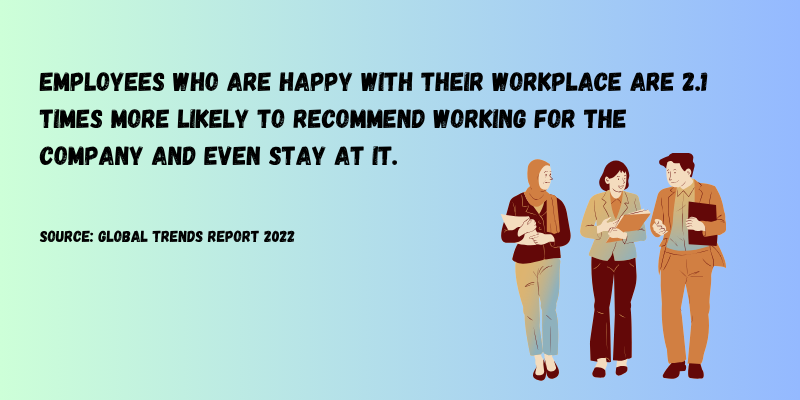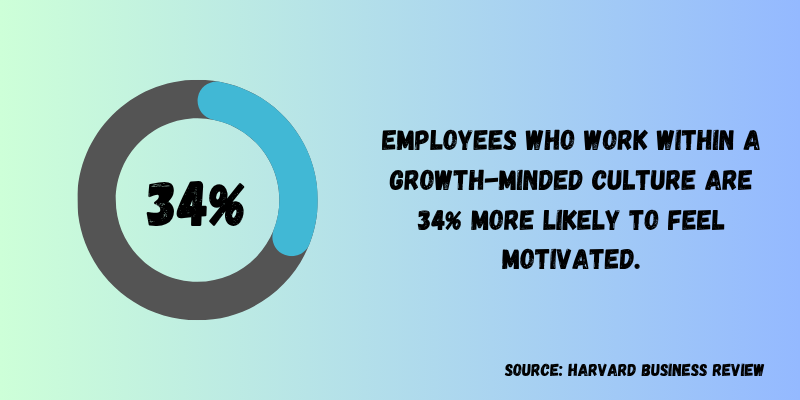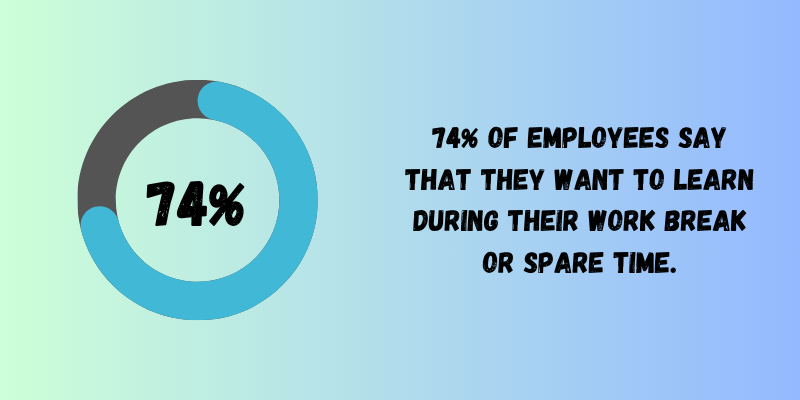Mindset Training: The #1 Skill Top Performers Practice Daily
Wondering how mindset training boosts employee performance and reduces turnover? Here's how shifting mental frameworks can increase motivation and drive retention.
Wondering how mindset training boosts employee performance and reduces turnover? Here's how shifting mental frameworks can increase motivation and drive retention.
.webp)
Mindset is the foundation for resilience, performance, and self-leadership. It is the filter through which employees see challenges, respond to feedback, and take initiative.
When a team lacks energy or drive, the root issue isn’t always skills, it’s often mindset.
The best part? That can be changed.
With the right mindset training, companies can turn disengaged teams into proactive self-leaders who thrive in uncertainty.
In this article, we’ll show you how mindset training drives retention, boosts motivation, and helps employees become self-leaders.
Let’s get into it.
Mindset training is structured learning that helps individuals shift from a fixed mindset "I can't change" to a growth mindset "I can learn and improve".
Through coaching, workshops, or daily practices, mindset training encourages employees to embrace failures as learning opportunities and to stay flexible under pressure.
According to Forbes, 96% of executives believe they embody a growth mindset, but only 45% of employees agree. This means that most employees believe their managers or team leads lack the necessary skills to support personal and team growth.
A shift from “I can’t” to “I can” makes a huge impact on your employees’ growth.
It teaches them to embrace challenges, bounce back from setbacks, and see learning as a continuous journey. When senior leaders model this growth mindset, they naturally pass it on.
This builds a culture where mistakes are seen as learning opportunities, not failures. And with the companies struggling to keep up with the changing trends, this mindset changes matters more than ever.
The best part?
According to Devlin Peck, 90% of the employees say that they’d not quit a job if they’re given the right growth opportunities and training.


Employee retention is one of the biggest challenges for any organization, along with keeping them motivated. Even though training, perks, and salaries, all matter, but mindset is the glue that holds people to your mission.
When employees believe they can grow, they don’t just stay longer, they commit deeper. That’s where mindset training plays a pivotal role.
Let’s explore how a shift in mindset can retain employees for longer:
When employees are trained to adopt a growth mindset, they begin to see their workplace as a place of opportunity. Instead of thinking, "I’m just not good at this," they begin saying, "I can improve with effort and guidance."
This mental shift increases commitment that is ultimately tied to employee retention.
A study by Stanford psychologist Carol Dweck, found that organizations promoting a growth mindset saw employees who felt significantly more empowered and loyal.
Training employees isn’t enough. What matters more is showing them that learning is continuous. When companies invest in mindset training, they nurture a learning culture, and that drives retention.
Moreover, the smart move here is to mix this form of training with leadership support and real-world application, telling your team: “We’re in this for the long run.”
For instance, instead of only offering skill-based training, you can run workshops on resilience, self-reflection, and goal setting. These shape how employees view personal growth and reduce the fear of failure.
A fixed mindset leads people to believe promotions are only for the talented few. But a growth mindset? It turns ambition into strategy.
When employees see their efforts leading to visible improvements, they’re more likely to stay. It can be in the form of a performance review, stretch assignments or maybe even new responsibilities.
All this reinforces the belief in employees that they don’t need to be perfect to move forward, just consistent.
Burnout isn’t always about too much work. Often, it’s about feeling like you’re not in control or not improving.
Mindset training can help change that.
By teaching employees how to reframe challenges and handle setbacks with self-compassion and perspective, organizations can dramatically lower emotional exhaustion.
For instance, a mindset coach working with a tech company taught junior engineers how to reframe code failures as learning milestones. The result? Team members reported a significant drop in stress-related time off over six months.
People don’t just leave jobs. They leave environments that drain them.
When your team is trained to approach problems with curiosity rather than blame, it creates a healthier atmosphere.
The Global Trend Report of 2022 also revealed that employees who are happy with their workplace are 2.1 times more likely to recommend working for the company and even stay at it.

However, this culture doesn’t build automatically, it starts with the individual. One employee who learns to manage their reactions, regulate their stress, and support their teammates can impact the entire team dynamic.
People with a growth mindset see challenges as opportunities to learn. Those with a fixed mindset view them as proof they’re not good enough. The difference matters more than you might think.
According to Harvard Business Review, employees who work within a growth-minded culture are 34% more likely to feel motivated.

Example: When faced with a failed sales pitch, a growth-minded employee asks, “What can I improve for next time?” Meanwhile, a fixed-minded one says, “I’m just not good at this.”
Mindset training often includes practices like self-coaching or positive affirmations. This is more of a neuroscience. Changing the way we speak to ourselves rewires our brain’s emotional pattern and makes us more motivated to take action.
An example of it would be an underperforming manager that trained in positive self-talk. He/she begins saying, “I’m learning how to lead better each week” instead of, “I’m a bad manager.”
Motivated employees often visualize success. Mindset programs teach guided visualization as a tool, just like athletes use to imagine winning games.
For instance, before a presentation, an employee could spend 2 minutes visualizing a confident, clear delivery. They walk in calmer and more prepared.
With the right mindset, motivation shifts from “I have to do this” to “I want to grow.” This is intrinsic motivation, and it’s far more sustainable than external rewards.
Example: A designer stops working just for bonuses and starts pushing boundaries to improve for the joy of growth.
Many employees wait to be told what to do. They follow the checklist. But mindset training shifts that. They start taking ownership. Why? Because they believe their actions actually make a difference.
Moreover, it teaches them to ask better questions like, “What else could be improved?” or “How can I make this smoother for others?”
Instead of focusing on limitations, they start spotting opportunities. That’s the difference between doing your job and leading your role.
One of the hidden powers of mindset work is how it turns self-evaluation into a habit. When employees regularly check in with themselves, they become aware of their triggers, blind spots, and energy patterns.
That awareness makes them pause before reacting. It helps them evaluate situations with perspective.
With self-awareness, employees can make better choices, build healthier relationships, and make fewer mistakes.
Fear of failure slows people down. If someone is afraid of making the wrong call, they hesitate, overthink and second-guess themselves into paralysis.
But when mindset training normalizes failure as part of growth, decision-making becomes lighter, faster, and more agile.
People don’t freeze. They act and they learn.
When you instil this type of mindset in your employees, they become more productive, think quickly and increase your business’s profitability.
You can’t just tell your employees to “change their mindset” and expect results. For mindset training to be effective, it needs to be structured, measurable, and adaptable to various learning styles.
Here’s how to design a mindset training program that actually sticks and scales.
Every good mindset program begins with a goal. Vague ambitions like “boost morale” won’t cut it. You need real, trackable outcomes that you see being fulfilled in real-time.
For example, if your company is struggling with turnover, your objective might be: “Reduce employee attrition by 15% in the next 6 months through resilience and mindset coaching.”
This clarity gives both employees and managers a shared direction and measurable progress to track. In fact, companies that have specific and defined learning objectives see an increase of 29% in ROI.

People learn differently. That’s why successful programs offer a variety of learning methods, such as microlearning, peer coaching, and real-time support.
Some formats through which you can deliver the training include:
This type of learning is also supported by various studies. Research shows that blended learning can increase retention by up to 60%.
Your entire team won’t learn at the same pace. In fact, 74% of employees say that they want to learn during their work break or spare time. That’s why you need on-demand access, so people can revisit and reflect anytime they want.

If you want mindset training to stick, you need more than just videos or PDFs scattered around. What truly works is a Learning Management System (LMS), like Coursebox, that brings everything together.
With this AI-powered tool, you can create and organize searchable video lessons and interactive quizzes for the employees. You can even use the AI tutor to guide learners in real time.
Plus, with its built-in analytics dashboard, you can keep track of exactly who’s engaging and who’s falling behind.
Designing a mindset training program can feel overwhelming. Maybe you’ve struggled to make your content engaging or maybe you don’t know how to bring everything together into one seamless experience.
And that’s where Coursebox comes in.
Unlike traditional LMS platforms, Coursebox is AI-powered and built for creators like you. With tools like the AI Image Generator, AI Tutors and AI Assessment, you can build courses that look good, teach better, and keep learners coming back.
We make it easy to build and scale impactful mindset programs. So, are you in?
Typically, mindset shifts within 4 to 8 weeks of consistent training. Microlearning (daily 5-minute exercises) and monthly workshops work well for most teams. For lasting change, plan for a program that lasts at least a quarter.
Not exactly. Resilience training focuses on bouncing back from stress. Meanwhile, mindset training is broader as it changes how people interpret success, feedback, failure, and purpose. Resilience is one outcome, but mindset training also enhances creativity and ownership.
They do! Especially when blended with coaching or live interaction. Courses that include interactive videos, reflective exercises, and live check-ins or group sessions help reinforce learning. This approach keeps participants motivated and improves knowledge retention, making mindset shifts more sustainable.
To train your mindset, start by practicing daily self-awareness. Catch your negative thoughts and reframe them in a more positive light. Set small, clear goals and celebrate your wins. Most importantly, surround yourself with people who genuinely challenge you. Over time, you’ll notice a positive shift in your mindset.
